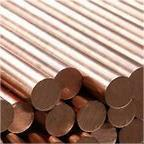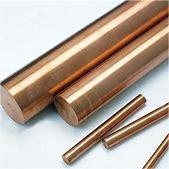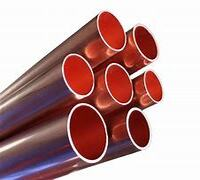1. Introduction
When you hear ‘copper rod,’ you might picture basic electrical wiring or plumbing. But in advanced engineering, copper rods are precision tools—engineered for specific, high-stakes roles. From stabilizing skyscrapers with lightning protection to enabling flawless copper-to-copper joints in aerospace systems, these rods are anything but ordinary.

This article dives into the niche, real-world applications of copper rod beyond the basics—focusing on earthing, specialized welding, and grounding innovations that keep modern infrastructure safe and efficient.
2. Copper Rods in Electrical Earthing and Grounding
One of the most critical uses of copper rod is in electrical safety systems—specifically, as an earthing rod copper or ground rod copper. These rods channel dangerous electrical surges safely into the earth, protecting buildings, equipment, and lives.
Pure copper rods offer excellent conductivity and corrosion resistance, but they’re expensive and mechanically soft. That’s why many engineers opt for copper bonded earthing rods—steel cores coated with a thick layer of electrolytic copper. Also called copper bonded ground rods or copper clad steel earth rods, they combine the strength of steel with copper’s conductivity.
- Copper bonded steel rods last decades, even in harsh soils.
- Common sizes include 16mm diameter x 2.4m or 3m lengths.
- The copper earth strip 25x3mm price is often compared when designing full grounding grids.
For those sourcing materials, terms like copper clad ground rod, copper clad earth rod, and earthing rod price frequently appear in procurement specs. The right choice depends on soil resistivity, expected fault current, and budget—but never compromise on conductivity or longevity.
3. Copper Rods for High-Integrity Welding and Brazing
In industries where leaks or joint failures are catastrophic—like refrigeration, semiconductor manufacturing, or high-vacuum systems—copper rod for welding isn’t just convenient; it’s essential.

Unlike steel, copper doesn’t oxidize easily when joined properly, but it requires specialized techniques. That’s where copper brazing rod and copper welding rod come in. These consumables are designed specifically for copper-to-copper welding rod applications, ensuring clean, strong, leak-free joints.
Copper to copper brazing rods often contain phosphorus (like BCuP alloys), which acts as a self-fluxing agent—eliminating the need for external flux in many cases. This is vital in HVAC systems using aircon copper pipe or ac copper pipe, where contamination can ruin compressor performance.
Professionals also use copper rod welding for repairing bus bars, electrical connectors, or even custom copper pipework in labs. The key? Matching the rod’s alloy to the base metal—whether it’s pure copper, beryllium copper strip, or a copper alloy strip.
4. Beyond Rods: Flat Forms and Strips in Specialized Roles
While rod copper dominates in 3D structural roles, flat copper forms—like copper strip, flat copper strip, or copper metal strips—serve equally vital niche functions.
Take the copper tape for snails, for example: an agricultural hack where thin copper strips deter snails from climbing planters. Or consider copper strip for earthing in switchgear, where flexible copper bus bar or nickel plated copper strip ensures low-resistance connections in tight spaces.
Recyclers and hobbyists often search for the best way to strip copper wire or fast way to strip copper wire—especially when salvaging copper strip wire from motors or transformers. Burning copper wire for scrap is discouraged (it releases toxins), so mechanical stripping or using a roll of copper strip for resale is preferred.
For precision work, specs like 1mm copper strip or beryllium copper strip matter. These appear in sensors, springs, and RF shielding—proving that even ‘simple’ copper forms enable cutting-edge tech.

5. Pricing, Sourcing, and Practical Considerations
Whether you’re buying a copper round bar for machining or comparing copper rod price vs. copper bonded options, cost is always a factor. Pure copper commands a premium—hence the popularity of copper bonded steel and copper clad steel ground rod alternatives.
Similarly, copper pipe price fluctuates with the LME, affecting everything from 15mm copper pipe for plumbing to 22mm copper tube for industrial chillers. But in earthing or welding, skimping on quality risks system failure.
If you’re searching for copper strip near me or copper bars for sale, prioritize certified suppliers. Look for ASTM or IEC compliance—especially for safety-critical items like earthing rods or bus bars.
And remember: while copper ingot price sets the baseline, fabricated forms like flexible copper bar or copper flat bar include value-added processing that justifies their cost in high-performance applications.
6. Conclusion
Copper rod is far more than a commodity—it’s a precision-engineered component enabling safety, efficiency, and innovation across niche fields. Whether grounding a data center with a copper clad steel earth rod, brazing an aircon copper tube with copper to copper welding rod, or deploying thin copper strips in sensitive electronics, the right copper form makes all the difference.
As infrastructure demands grow more complex, the humble copper rod continues to prove its worth—not in volume, but in reliability where it counts most.
Our Website founded on October 17, 2012, is a high-tech enterprise committed to the research and development, production, processing, sales and technical services of ceramic relative materials such as Copper. Our products includes but not limited to Boron Carbide Ceramic Products, Boron Nitride Ceramic Products, Silicon Carbide Ceramic Products, Silicon Nitride Ceramic Products, Zirconium Dioxide Ceramic Products, etc. If you are interested, please feel free to contact us.

